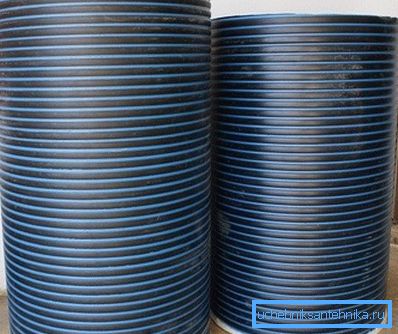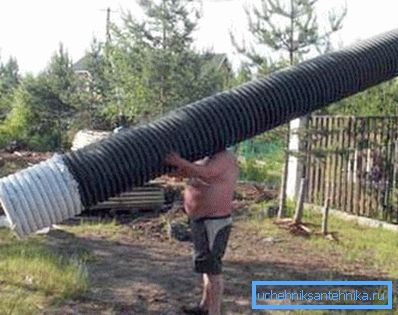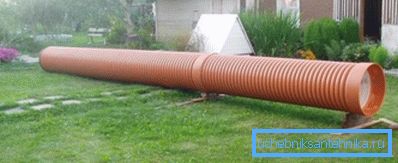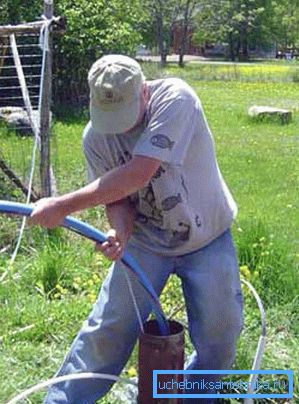Is it possible to use plastic pipes for a well
Having decided to buy a house in the country, the first thing to do is to check whether there is water and electricity on the plot. If it is still possible to solve the latter problem somehow, then the second one can become the stumbling block that will not allow to buy this particular area, no matter how beautiful it is.
Drilling a well on water or a well device, which will be discussed later, can help.

Plastic Well
The main problem of all sources of drinking water is pollution by their surface waters, for which protection methods have been developed. One of them - instead of the traditional concrete well rings installed seamless plastic pipe for the well. It has no seams and therefore the overhead will not be able to seep into the mine, and the geotextile layer will prevent the source from zapochechivanie.

But there is one nuance, you need to accurately get to the aquifer, so that there is a sufficient flow rate of the well. At its core, a plastic pipe well is a drainage pipe that collects groundwater..
Process
We offer instructions for the manufacture of plastic wells:
- Purchase a plastic double-layer pipe with an internal diameter of 400 mm. These products are intended for installation in soils.
- Invite a specialist to determine the strongest point of the underground key on the site.
- Start digging under the open source.
- When you reach a depth of 2 meters, start forming a round hole until you reach the aquifer.
- Begin to prepare the plastic pipe for installation in the mine seamless wells, after it has hammered the key.
- To a height of 500 mm in the cavities of the fins, drill numerous holes using an O 7 mm drill bit.

- Wrap the lumen of the pipe and the hole with geotextile in two layers.
- Use a plastic sheathed wire to secure the well filter. It will pass water well, but will not let the sand pass through.
- Bring the prepared pipe to the place of the future well and lower it into it. Make sure she got to the bottom of the mine.

- Fill the pipe with sand, and insulate the top to a height of 1 m with foam.
- Lower the submersible pump into the well to begin to rock it.
Tip: After the buildup, you can load a layer of shungite and quartz sand into the lumen of the pipe to improve water quality.

Other options
Needle Well
Another version of the use of plastic, but already significantly smaller in diameter - up to 1.5, a device with the help of the Abyssinian well. Of course, it is not so durable that it can be used to pierce the soil to the aquifer, but then it can fulfill its role later. Slice the pipe by 1-2 m and build up one another as the well goes deeper.
Tip: achieve maximum reliability of the connection here, so as not to damage the entire structure.
To facilitate the penetration of soil at the end of the pipe, a needle filter is made, which will also protect the source from silting and will be a coarse filter from mechanical particles. Such an Abyssinian well made of plastic pipes is inexpensive to manufacture and serves for quite a long time.
Well
To date, the well is considered the most popular. It can be made with your own hands if the ground allows, or you can entrust professional drillers when the ground is heavy, especially rocky.
Casing
They differ from ordinary wells not only in depth, but also in the presence of casing. If you used mostly metal, now more and more often give preference to PVC materials, if the well depth does not exceed 50 m.
Features:
- they are lightweight, which makes installation easier;
- the price is cheaper, which affects the total cost of the well;
- service life more than 50 years;
- resist various chemical reagents;
- reliably connected by a threaded connection;
- do not rust.

The use of plastic today is dictated by the struggle for the quality of drinking water. In addition, due to the smaller diameter than the metal counterparts, work is carried out much faster.
For plumbing
You can raise water from a well in two ways - push it to the surface with a deep well pump or get it superficial, the latter can do it without refitting from a depth of no more than 7 m.
Plastic pipe in the well, installed instead of metal, simplifies the work and does not pollute the source. It also has the advantage over rubber, as it does not shrink during operation.

Connecting a well submersible pump is also easy. The most commonly used threaded connection, which plastic tightly pressed to the output of the equipment. The second end is fixed in a caisson or a pit, distributing water further along the water supply system.
If you have a shallow source, you can use a pumping station to raise the water to the surface, where a hydraulic accumulator is already provided, which allows you to extend the life of the equipment.
In this case, a check valve is attached to the end of the plastic pipe, and the other end is attached to the station at a right angle with the help of plastic elbows. Pour water into the water supply system and begin to lift it from the well, while the plastic will not shrink, ensuring a normal passage of water.
Conclusion
The use of plastic pipes specifically designed for drinking water improves its quality and facilitates installation. You do not need to fear or to make additional work to protect the well from the upper layer. In the presented video in this article you will find additional information on this topic.